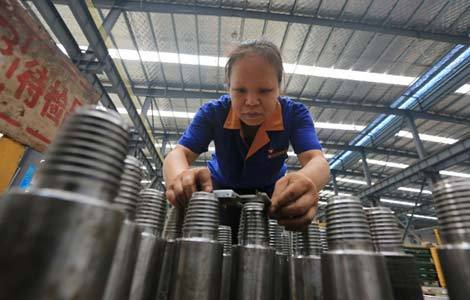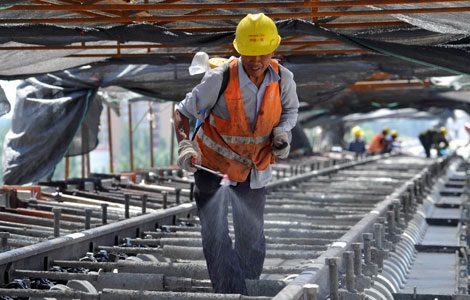Asian garment industry to undergo further segmentation
Updated: 2013-07-15 16:06
By Liu Xiaozhuo (chinadaily.com.cn)
|
||||||||
TheAsian garment manufacturing industry will undergo further segmentation in the next three to four years as competition becomes more intense, experts said. China, Thailand and Vietnam will mainly produce high-end clothing, while Bangladesh, Laos, Burma and Cambodia will mainly produce low-end clothing.
At present, the majority of garments within the global marketplace are produced in Asia. Between 2005 and 2011, Vietnam's garment export increased by 32 percent and China's increased by 15 percent. Percentage number increases for India, Turkey, Malaysia and Thailand were at about 7 percent, according to data from the Vietnam Textile & Apparel Association (VITAS).
Statistics from the Thai Garment Manufacturers Association (TGMA) have revealed that garment exports from China account for 35 percent of the world's garment export business. Bangladesh, India, Pakistan and Sri Lanka occupy 16 percent to 18 percent of the global market. For Southeast Asian countries the numbers range from 10 to 12 percent.
As start-up capital is not high and Asia has plenty of cheap labor, the garment manufacturing and textile industry play important roles in the economic development of many of Asian countries while also having a significant effect on people's interests.
Lu Qijian, secretary-general of the Garment Manufacturers Association in Cambodia said that Cambodia's garment and textile exports make up more than 80 percent of the country's gross export business. Its contribution to the nation's GDP accounts for 15 percent to 18 percent. The garment export income of Bangladesh makes up about 78 percent of the country's annual foreign exchange income.
Though the garment industry in southern and Southeast Asian countries is booming, its development still faces limitation challenges. One major problem has been the rise in labor costs.
Cheap labor has always been an advantage of the Asian textile and garment industry as it is more evident in South Asian countries. But in recent years, labor costs have been rising. Minimum wage in Vietnam has gone up by 20 percent, and Indonesia and Laos are at 20 percent and 22 percent this year. The average monthly salary for a Cambodian is almost 100 dollars, which leads to labor shortage issues.
In addition to labor, investors also have to deal with low productivity and bad product quality concerns. Moreover, it has been hard to raise Southeast Asia's garment industry net value because it is too dependent on raw material imports.
A general manager of a Thailand textile company said that at present only Thailand can carry out production of all the domains within the garment industry. Cambodia and Bangladesh are lacking in raw materials and can only produce ready-to-wear apparel.
According to Vietnamese media, 11.8 percent of the fabric needed by the Vietnam garment industry is produced domestically. Most high-end fabric is imported. In 2012, Cambodia imported from the Chinese mainland, Taiwan, Thailand, Japan and South Korea raw materials worth $3.12 billion.
Compared to China, Southeast Asian countries and South Asian countries have more labor advantages. Therefore, some Chinese low-end garment manufacturers are moving there. Lu Qijian said that the high-end garment industry still thrives in China because China has advanced technology and high-end skills.

 Obama urges restraint amid protests
Obama urges restraint amid protests
 Putin wants Snowden to go, but asylum not ruled out
Putin wants Snowden to go, but asylum not ruled out
 Apple to probe death of Chinese using charging iPhone
Apple to probe death of Chinese using charging iPhone
 Investment falters as industrial activity flags
Investment falters as industrial activity flags
 Rape victim's mother wins appeal
Rape victim's mother wins appeal
 Reproduction of 'Sunflowers' displayed in HK
Reproduction of 'Sunflowers' displayed in HK
 Land Rover enthusiasts tour the world
Land Rover enthusiasts tour the world
 US star sprinter fails drug test
US star sprinter fails drug test
Most Viewed
Editor's Picks

|

|

|

|

|

|
Today's Top News
Spain apologizes to Bolivia for plane delay
International cotton contract in the works
Smithfield shareholder still presses for break up
China calls for new talks on Iran nuclear issue
Global warming may largely raises sea level
Putin wants Snowden to go, asylum not ruled out
US: China can balance own growth
Top foreign study destinations for Chinese
US Weekly

|

|






